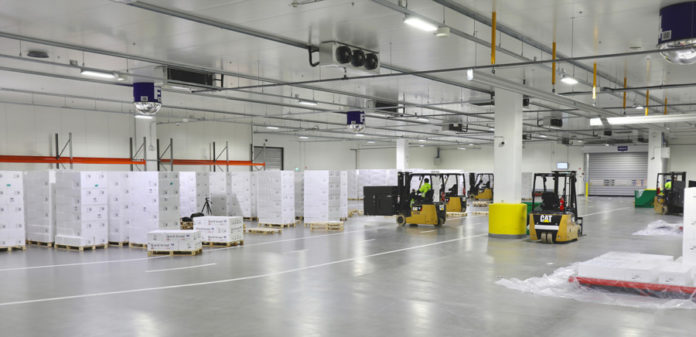

British taste for frozen guacamole from Mexico has created good business for Panalpina Air Cargo.
Forty-two tonnes were moved in six weeks in ten shipments recently. Flown from Guadalajara, Mexico, via Huntsville, USA, to Stansted, UK on scheduled charters of the Panalpina Charter Network, the product was transported on the lower deck of a Panalpina’s 747-8 freighter, with the ambient temperature set at 2 °C. Palletised, the goods had thermal covers (passive cooling) used for each pallet to maintain the temperature of the cargo during transport.
There was immediate onward distribution from Stansted Airport to the customer in Braintree, Essex on arrival, with each shipment delivered to the customer between two and maximum five hours after the aircraft had landed.
In mid-December, 2017, Finnair staged the official opening of a new 80 million euro Cargo terminal COOL for its perishable cargoes. At an opening attended by Finland’s Minister of Transport and Communications, Anne Berner, guests were introduced to the new terminal’s most striking features, including the new high-tech Cargo Control Center (CCC) that intelligently manages and optimises the flow of goods and steers the performance of the hub.


The new COOL terminal had opened its doors for seafood shipments in October, and at the opening, Finnair showcased salmon frequently transported on its flights to Asia and other key international destinations. Finnair managing director Janne Tarvainen (pictured) explained that salmon was a natural choice for the event because it is one of the products that benefit from the use of modern technology to monitor transport.
Tarvainen says: “We transport 20 million kilos of salmon each year, in part because of the competitive advantage offered by the geographical location of Helsinki. We call it the short Northern route and it means salmon fished in Norway can reach a diner’s table in Tokyo in 36 hours. That might be fresher than the fish in your local supermarket in Helsinki.
“Salmon is only one part of our cargo, but its journey showcases the kind of speed, focus on highest quality, and use of the best technology that have been our guiding principles in this 80-million-euro investment. With salmon and other seafood, it is essential they are transported at the right temperature and our new Cargo Eye monitoring system together with temperature monitoring trackers makes sure the salmon is kept in ideal conditions all the way to its destination.”
Sustainability has been at the forefront of planning and design of the new terminal and in late December on Finland’s 100th Independence Day, the new COOL Nordic Cargo Hub at Helsinki Vantaa airport was awarded a rating of “Very Good” by one of the world’s leading sustainability assessors of buildings, BRE Global Ltd.
In August 2017 the first direct flight from Canbarra, Australia to Singapore was used by producers throughout the national Australian capital region for the first shipment of local perishables direct to Singapore from Canberra airport. Producers were able to get their wares to Singapore within a day of an order rather than the five days such cargoes normally took through Sydney.
The inaugural shipment on Singapore Airlines comprised fresh bacon and smoked salmon from Pialligo Estate; Helm Wines and Ravensworth Wines from Murrumbateman, Nick Spencer Wines from Canberra, Lark Hill wines from Bungendore and Nick O’Leary Wines from Lake George as well as Fedra olive oil from Collector. The produce ended up at international hotels, supermarkets and leading restaurants in Singapore.
Rose growers in Kenya are set to benefit from Kenya Airways new non-stop daily New York flight which launches in October 2018. It becomes the first airline to offer a non-stop flight between East Africa and the USA. The airline will operate a Boeing 787-8 Dreamliner with a cargo capacity of 137 m3 (4,826 cu ft). The flight will depart daily from Jomo Kenyatta International Airport hub in Nairobi.
While Kenyan roses have taken 40 per cent of the EU’s rose market, the percentage making it to the United States is considerably smaller. It suffers in the US market by being more expensive than competing South American produce. The Africa Growth and Opportunity Act afforded Kenya and other developing countries duty-free access of some goods into the US market. The cut flower sub-sector is Kenya’s top forex earner but has remained underexploited.












